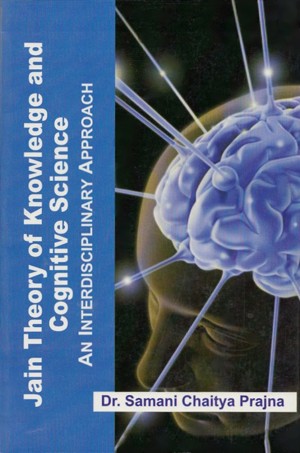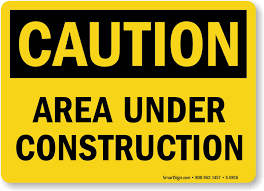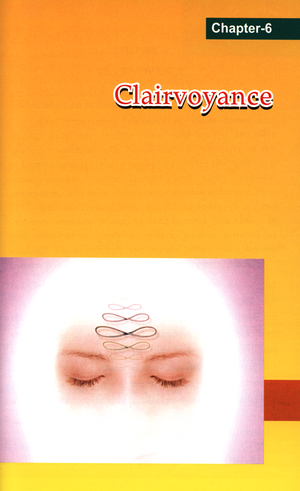
6.0 Introduction to Clairvoyance
The three terms 'clairvoyance, clairaudience and clairsentience' refer to clear vision, clear hearing, and clear sensing respectively. Of course they do not refer to the ordinary physical sensory perception; rather they refer to a super sensual, super normal and super physical perception.[1] The term clairvoyance has been derived from (17th century French term 'Clair' meaning clear and 'voyance' meaning vision) is used to refer the ability to gain information about an object, person, location or physical event through the means other than known human senses. It is a form of extra sensory perception.
6.1 Clairvoyance: An Extra Sensory Perception
Avadhijñāna is the technical term used for clairvoyance in Jainism. According to Jainism, there are three stages of supernormal consciousness as has been indicated previously. The first stage known as Avadhijñāna is limited to the material objects. Avadhijñāna is the supernormal cognition of material objects. It is known as avadhi, because, its sphere of apprehension is limited to material objects gross or subtle.[2] It resembles to clairvoyance or clairaudience of the modern psychology. But, there is a slight difference in both the views. According to Jainism, all cognitions related with avadhi are produced direct by the soul. The senses do not play any role in such cognition. In the scripture 'Nandīsūtra'[3] two kinds of clairvoyance are mentioned:
- Clairvoyance taking place from one part of the body (antagata),
- Clairvoyance taking place from the middle part of the body (madhyagata).
These divisions of clairvoyance have been made on the basis of the part of the body from which the knower views something through knowledge.
Clairvoyance taking place from a part of the body: t knowing objects of a particular direction from certain part of the body is known as clairvoyance taking place from a part of the body. It is of three kinds:
- Clairvoyance acquired from the front side of the body (pūrvagata),
- Clairvoyance acquired from the back side of the body (madhyagata),
- Clairvoyance acquired from the right and the left side of the body (parśvagata).
Clairvoyance acquired from the front part of the body:
It is the knowledge that is acquired from the front side of the body. The clairvoyance that comes to know knowable substances located on the front side directly through the soul, without any help from mind and senses is known as clairvoyance acquired from the front side. In this clairvoyance, no knowledge is acquired of the substances located at the back side or at the right or at the left side.
Knowledge of the substances located at the front side only is acquired. It can be better explained with the example of the sense organ of seeing. Just as with the sense organ of seeing (eyes), a person comes to know of the objects located at the front side only and not the objects located at the back or at the right or at the left side. Similarly, in this type of clairvoyance, cognition of the objects located at the front side of the body is acquired.
Clairvoyance acquired from the back side: This is the clairvoyance that is acquired from the back side of the body. The knowledge that is acquired, not of the knowable objects located at the front side, but of the knowable objects located at the back side, directly through soul, without the help of senses and mind, is known as the clairvoyance acquired from the back side. It can be better explained with the example of the sense of touch. As a person feels the sensation of touch on the skin of the back, in this kind of clairvoyance, knowledge of the objects located at the back side and not at the front, is acquired.
Clairvoyance acquired from the right and the left side of the body: Clairvoyance that does not recognize the knowable objects located at the front side or at the back side, but knows the knowable objects at the right or the left side, directly with the help of soul, and not without the help of sense organs and mind, is known as clairvoyance acquired from the right or the left side of the body. It can be better explained with the example of sense organ of verbal knowledge. Ears are located at the left and the right side of the body. Similarly, clairvoyance gains knowledge of the objects located at the right or at the left side. This knowledge can be acquired from either of the two sides and from both the sides.
Clairvoyance taking place from the middle part of the body, The knowledge, by which a person possessing clairvoyance knows the objects of all the sides ae right, left, front or back directly, is known as clairvoyance taking place from the middle part of the body. It can be better explained with the help of an example. When a person carries a ruby or a lamp or any other source of light on his head, its light falls on all the sides- right, left, front and back, therefore, things lying at all the sides are illuminated. Similarly with the help of 'clairvoyance taking place from the middle part of the body, a person knows the objects located in all the sides directly by soul, without the help of sense organs and mind.
The only difference between clairvoyance taking place from one part of the body and clairvoyance taking place from the middle part of the body is that a person possessing clairvoyance of one part of the body gains the knowledge of the objects located in one side only and the person possessing clairvoyance taking place from the middle part of the body gains knowledge of objects located in all the sides.
6.2 Clairvoyance and Endocrinology
These parts of the body according to Jain Scholars[4] can be several psychic centres related with glandular especially endocrine system of the body.
There are thirteen psychic centres in Preksha Dhyana as per Acharya Mahaprajna which are of scientific importance too as follows:[5]
Table No.6.1 Clairvoyance and Glands
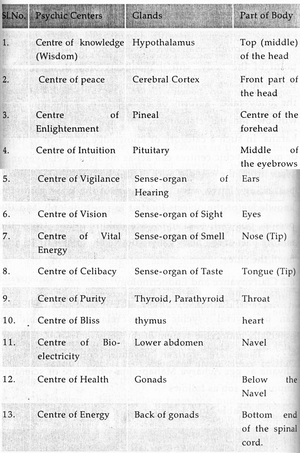
Although, clairvoyance can occur from the any point of the body, still it manifests only through those parts which acts as a medium of manifestation. That part of the body takes a form of an aperture, a medium or a window for the clairvoyance to manifest is known as karaṇa. In such a category of knowledge one, two or three or many psychic centres can act as medium of clairvoyance at a time.
These kinds of aperture or windows of clairvoyance can be of various shapes not as sense organs really because they acquire the shapes only when they turn themselves as a medium of Extra Sensory Perception. These shapes are of many kinds such as drum, conch, pot, swastika etc. In Patanjaili's Yoga system too, the concept of chakras and lotus are well known.[6]
According to Nemichandra, the clairvoyance through spiritual aspiration occurs across the symbols or shapes such as conch and others, the commentator gives the examples like lotus, diamond, swastika, fish, pot, etc..
The interesting fact about them is that these shapes are both auspicious and inauspicious. The inauspicious shapes are liable to change. On the occurrence of enlightenment, the inauspicious shapes transforms themselves into auspicious ones.
5.3 Clairvoyance and Psychic Centers
Etymologically, though different but terms Sandhi, karaṇa, cakra, caitanya, kendra or psychic centres though terminologically all of them point to the same object i.e. condensed consciousness. When viewed historically, the original term seems to be Sandhi in Jain scriptures. As context changed, the term sandhi took newer forms and wore- new names. The use of term karaṇa in the cognitive context and marina is context of mystical power. The changes in the use of terms seem due to the influence of other contemporary philosophies of those times. At present, when there is again need of spirituality as an antidote to materialism, Acharya Mahapragya stipulated a novel term of chaitanya kendra or psychic centres for the ancient concept of sandhi. This concept is more clear than sandhi as it directly points to its meaning as the centre of psyche i.e. consciousness.
Living beings in their worldly existence according to Jain metaphysics is a combination of two entities: soul and body. The soul resides in the body. The two subtle bodies -I the Taijasa (i.e. the electrical body) and karma-body exist in the interior of the gross body and the soul is further in the interior of these two. One, who practices the concentrated perception of the phenomena and sensations of one's gross body, gradually succeeds in perceiving the subtle bodies. By further practice of that particular technique of meditation and training the mind for such perception, one begins to realize the current of consciousness flowing in the certain parts of the gross body called as psychic centres.
Thus body and its parts are basic instruments 01 doors to enter into the inner world. Psychic centres in true sense are the doors of consciousness. Once these doors are opened, the consciousness becomes unobscured leading to the emergence of extra sensory perception as mentioned above.
The light of super-sensuous knowledge spreads out of the karmic aperture. In the Nandí Cūrṇi, it is said: the purity of the soul by shedding of karmic particles enlightens the particular parts found in the body to act in a particular direction of cognition. This is the reason why the clairvoyance emerged due to the purity is described as situated in the body. In the case of the purity of all the soul units the clairvoyance that functions in a particular direction is described as situated in the body.
This explains that the different parts of the body (back, middle, front) can act as medium of immediate perception.
The doctrine that confirms such view is also available at other places. Ṣaṭkhanḍāgama describes that these places in the body can be of various shapes. In connection with clairvoyance, the word karaṇa is explained as an organ of the body or a part of the body through which the clairvoyant knows the objects. These organs are of various shapes.[7] Marmāṇ, in the opinion of Mallisena, the sensitive centres are the parts of the body, dominated by dense soul-points. In Syādvadamañjarī[8] Mallisena, 13th cent. A.D. defines the term marman as: Bahubhirātmapradśairadhiṣṭhitā dehāvayavā - This means the organs of the body having condensed soul points. However, the term was originally used by Hemacandra is - paramarma bhindannaho in his Anyayoga Vyavacchedikā. (V.10)
Table No.6.2 Names of Centres of Clairvoyance Coined by Various Jan Scriptures
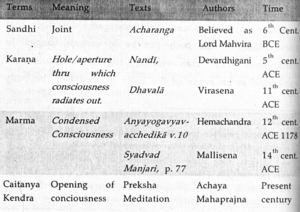
Presently, the same concept has taken the form of psychic centres. This is a basic contribution of Acārya Mahaprajna in this field. Through the new technique of Preksha Dhyana - Agama aur Āgametara srota, by Dharmesh Muni[9] deals with scriptural basis of the psychic centres.
There is no mention of ṣaḍcakra (six cakras) in Yoga sutra of Patanjali, however the concept of cakra in its roots can be derived in the following aphorisms[10]
nābhi cakre kāyavyūhajṅānaṁ /
kaṇṭakūpe kṣutpipāsānivṛttiḥ /
kūrmanāḍyāṁ sthairyaṁ /
mūrdhajyotiṣi siddhadarśanaṁ /
hṛdaye cittasaṁvit
In the commentary of Yoga sutra of pataṅjali, ānābhi cakre, puṇḍarīke mūrdhni jyotiṣi nāsikāgre jihvāgre, ityevamādiṣu deśeṣu, bāhye va viṣaye cittasya vṛttimātrṇa bandha iti dhāraṇāa meaning
A description of cakras involves in first place an account of western anatomy Central Nervous System and Autonomous Nervous System. Secondly in tāntrika anatomy or in Yoga, it is defined as circles or depressions of the body for mystical or chi-romantic purposes and their positions has in almost every particular been wrongly given[11]. Cakra may be shortly described as subtle centres of operations in the body of powers of various principles which constitute bodily sheaths.
Modern books on Yoga as journey through the cakras (1987) written by klausbernd Vollma deals anatomically with seven cakras depicting the methods of activating them. Kirpal Singh's (1980), book 'The crown of life - A Study in Yoga', is basically a comparative study in yoga, which includes various forms of yoga including some modern movements as Rosicrucianism, Theosophy, spiritism and spiritualism, hypnosis and mesmerism.
Shri Anand (1981) in his 'Develop your Latent Powers through Yoga ' illustrates in detail coloured images of the cakras with their functions. It also deals with various exercises that can help in developing one's inner power. Yoga and the Hindu traditions by Varenne Jean (1989) also has a chapter on serpent power which deals with various aspects of the cakras as names, locations, geometric shapes, colour, number of petals, sound and cosmic power related to them. Yoga beyond Meditation, consists of Vimala's dialogues on Yoga Sutra at Dahousie 1996. It deals with major question that can arise while reading and practising Patanjali's Yogadarśana dealing each of its pāda indecently.
Sir John Woodroffe's Serpent Power, is primarily based on two important books ṣaḍcakra Nirupaṇā on laya yoga and Pādukā Pañcaka the with elaborate introduction, which critically describes the philosophy of cakras. A recently published book on cakras called Psychology of the Cakras is unique contribution of Richard A, Jelusich (2004). This book deals in detail with all cakras including major and minor and evolutionary spiral in a systematic flow of twenty five chapters. It also deals with the characteristics and effects of each cakra when it is dominant on the personality. The book also serves a practical guide to know own position and develop in spiritual upliftment. Various faculties and divinities are supposed to be present in these hollows.
The word vivaraṁ[12] means in Sanskrit-English Dictionary of Apte the fissure, cavity, hollow, etc. It also sometimes means medium of cognition. Apart from the above mentioned terms the word karaṇa is also used as a synonym of it. It is explained that the meaning of karaṇa is cakra or psychic centres.
In Sanskrit-English Dictionary of Apte, the word marman is defined as vital part of the body, the vitals, Any weak or vulnerable point, Any joint of a limb, The secret or hidden meaning, a secret, a mystery.
In Monier-Monier Williams Sanskrit-English Dictionary, the word marman is derived from mṛi which means mortal spot, any open or exposed or weak or sensitive part of the body, the joint of limb, the hidden meaning A secret, a mystery.
Contextual analysis of the synonyms of Karana, Vivara, Marma, Cakra, Chaitanya Kendra shows that different synonyms have their own particular meanings but denotes a single object i.e. uncovered consciousness. Due to the variation of the context, the same concept of sandhi wears new shapes. For example, in the context of spiritual development the word sandhi has been used. Here, in the life of non-violence the person who desists from violence, or non-restraint or laxity, could see or identify the juncture while practising non-violence. Here the word 'sandhi'(juncture) as that are relevant in the present context:
As in Ācārānga, there the meeting points of body and soul has been emphasized as Sandhi. On the other hand in the cognitive context the word karaṇa has been used to emphasize the uncovered consciousness which is immediate means of perception. The word marma that is been used by Hemacandra emphasizes the vital points of the consciousness and at present in the age of materiality, when there is a need of spirituality, Acarya Mahaprajna Coined the new word caitanya kendra for the same old concept of sandhi. A detailed analysis of all these synonyms whether it be a hole in the karmic veil or manifestation of immediate consciousness or a condensed form. Of consciousness or a centre or nuclei of the psyche, all refer to the same object of pure consciousness.
Clairvoyance and Meditation
Extra Sensory Perception is the ability which is described as vibhuties in Patanjali's philosophy. The third chapter of Patanjal yoga darshan is termed as vibhūti pada in which various forms of vibhuties have been described as knowledge of the past, present and future, knowing minds of others psychic hearing, touch, vision, taste and smell and knowledge of previous existences. Clairvoyance is one of them. The term used for clairvoyance is viprakṛṣṭa jñāna i.e., distant knowledge. These vibhuties or extra sensory perception can be attained by activating some sensory centres of human body with the help of different yogic exercises such as meditation or advanced level of sadhanas.[13] For instance, according to yoga experts clairvoyance, telepathy extraterrestrial communication can be bestowed by the activation of ajñācakra (the inner core of brain deep behind center between the two eye brows). The meditational and yoga practises can stimulate and illuminate this third eye. There is a strong evidence of above mentioned facts as Indian rishi-munis, through the their spiritual aspirations could attain such riddhis (special powers) and cognitive abilities. A study of Muni Dharmesh also accords with this fact. Through his empirical study he found positive correlation between clairvoyance and meditation.[14]
In modern era is of virtual science. Computers or Artificial Intelligence can do many of the jobs that could be done by humans only. Application of computer networks remote sensing forecasting, seismography, weather, satellite etc. are designed to give clairvoyant like capabilities, although there exists a vast difference between both artificial and human intelligence.
Thus, it is concluded that clairvoyance is of many types. It can occur in humans by gradual spiritual evolution. The medium of clairvoyance can be any part of the body or any gland. Clairvoyance occurs there where conciousness is pure or purged of the karmic impurities. On account of unveiling of the karmic impurities, many kinds of extra ordinary abilities can manifest, clairvoyance is one of them. Even machines can show such abilities, if provided with such software programmes. The higher stage to this is mind reading in Jain Epistemology which is discussed in the subsequent chapter.
Ṣaṭkhanḍāgama, Book No.-13, Khanda No.5, Part 5, Sutra 57,58, p.296: khetta do ta va aneya-san{:ha nasantthida sirivaccha-kalasa-sakha-sotthiya-namdavattadini samthana ni na davva ni bhavanti
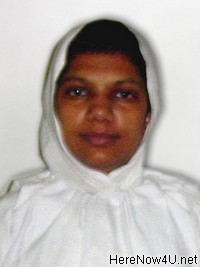 Samani Chaitya Pragya
Samani Chaitya Pragya
